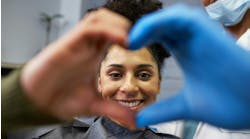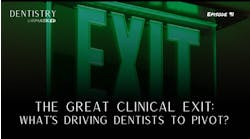Interview with Dr. Joshua Austin: A pragmatic approach to isolation
[Q] Hey, Josh, I know you spend most of your time chairside with a handpiece. What are your thoughts about a pragmatic approach to isolation?
[A] Hey, Pam! I am just a mere general dentist, not a super prosthodontist like you, but I have big feelings about isolation.
[Q] Who but you would have strong thoughts on something as mundane as isolation? And by the way, super prosthodontists aren’t super without caring about isolation!
[A] I know, right? Every restoration I do is under rubber dam isolation, but I have a lot of rubber dam guilt. I feel like I failed a lot of students when I taught operative at UT Health. We required rubber dam isolation on every restoration. Not only that, but the students had to isolate from the second molar to the contralateral canines. It was unreasonable. We created a lot of dentists who hated rubber dams. We all know and understand that rubber dam is ideal, but often it just doesn’t happen.
[Q] I know! I agree. Rubber dams are great, but most prosthodontists won’t ever touch one either. So what options do we have?
[A] We are really in a golden age of rubber dam alternatives. I think most dentists use cotton rolls and dry angle type products. Cheap. Easy. Plentiful. But I am not sure that they are what we should be looking toward. They don’t help reduce the humidity in the mouth at all. If we can get rid of some of the moisture that cotton rolls hold on to, we can have better restorative and adhesive dentistry outcomes.
[Q] Good point, and I agree that cotton rolls can be problematic. What have you found that works?
[A] Well, I think the most sophisticated answer on the market is the Isolite Pro by Zyris. Obviously, Isolite has been around for a minute, but it seems like they keep upping the quality and features of the product over time. When I started my practice, we outfitted my restorative operatories with Isodry devices. These were nice, but they had no light and only worked for posterior teeth. Over time, I updated these devices to the newer Isolite Pros.
[Q] What is different in the newer device?
[A] The light does make a difference. Yes, I have a headlamp on my loupes. Yes, I have an overhead light. It never seems to be enough though. From time to time, we forget to turn on the light on the Isolite Pro, and then I will notice the difference and turn it on. Even with my overhead light and my headlamp, the Isolite Pro illuminates the field much better, which increases my vision. The effect that this “in the mouth” light has is kind of stunning, even with all our adjuncts.
[Q] As a devoted headlamp user, I would have thought this wouldn’t make that much of a difference. I do a lot of cosmetics, so my impression was that Isolite really didn’t help that much when prepping front teeth.
[A] Yeah, for a while, the mouthpieces were really for posterior only: the traditional bite block, cheek and tongue retractor, suction device we think of when we think of the Isolite/Isodry products. Recently, they came up with an anterior solution, which is amazing. The anterior mouthpiece with the anterior adapter tends to keep the tongue out of the way and give the patient a bilateral block to bite into. It gives a bit of lip retraction, but when I pair it with a Hoopla, I get really amazing isolation for anterior teeth.
[Q] What the heck is a Hoopla?
[A] Hoopla is a quick, easy, effective, streamlined lip retractor. The Hoopla doesn’t slide around or pop out of my patient’s mouth, which allows me to be more efficient. On top of that, they are really inexpensive and work incredibly well. I use a Hoopla for every veneer and anterior prep I do. When used in conjunction with an anterior mouthpiece on the Isolite Pro, I can simply click on cruise control for my anterior dentistry. Easy mode!
Editor's note: This article appeared in the April 2025 print edition of Dental Economics magazine. Dentists in North America are eligible for a complimentary print subscription. Sign up here.








